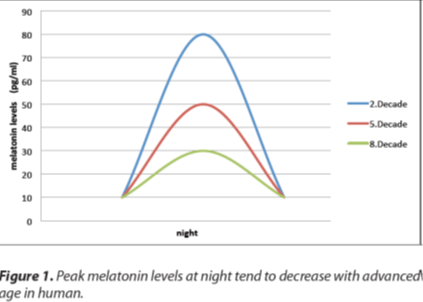Melatonin, Its Receptors and Drugs
Melatonin and Associated Pathologies
- Melatonin is a hormone secreted from the pineal gland at night.
- increases the sleep during night but has no effect on latency or duration of sleep.
- Used to reduce symptoms of jet lag. It can also synchronize the sleep wakefulness cycle in shift workers and
- is also used in elderly hypnotic dependent insomniacs.
- Lowering of seizure threshold and psychiatric changes are the possible adverse effects.
- Its peak levels in the dark are associated with age as well as various illnesses

- Melatonin plays roles in regulating sleep-wake cycle, pubertal development and seasonal adaptation
- Melatonin is related with memory, and its associations with control of body posture and balance have been shown.
- Melatonin regulates memory formation by directly affecting hippocampal neurons
- Melatonin has antinociceptive, antidepressant, anxiolytic, antineophobic (being afraid of new things) and locomotor activity-regulating effects
- Dopaminergic system is important for behavior and rewarding and also in cases of drug addiction such as cocaine à Melatonin inhibits dopamine release.
- Melatonin production is reduced with aging, various cancers, Alzheimer’s disease, senile dementia, pineal calcification, cardiovascular disorders and hypothalamic hamartoma or craniopharyngioma which lead to precocious puberty in youngsters
- Other disorders in which melatonin was shown to be reduced are stress, pain, endocrine and metabolic disorders, particularly DM type 2 and acute intermittent porphyria.
The Mechanism of Effect of Melatonin
Melatonin shows its affects by four mechanisms in mammals:
1. Binding to melatonin receptors in plasma membrane
2. Binding to intracellular proteins such as calmoduline
3. Binding to Orphan nuclear receptors
4. Antioxidant effect
Melatonin interacts with intracellular proteins named calmoduline, calreticulin and tubulin.
Calmoduline is an intracellular secondary messenger à Melatonin directly antagonizes binding of calcium to calmoduline à The anti-proliferative effect in cancer may be related to this.
Melatonin receptors
There are three different membrane receptors and one nuclear receptor:
1. Melatonin receptor type 1a: MT1
- commonly found in human skin.
- During aging process and Alzheimer’s disease, the expression of MT1 receptor in suprachiasmatic nucleus (SCN) and cortex decreases
- MT1 receptors reduce the neuronal discharge rate in SCN and suppress prolactin secretion [8].
2. Melatonin receptor type 1b: MT2
- In the skin, MT2 receptors are located within normal and malign melanocytes and eccrine sweat glands
- In Alzheimer’s disease, MT2 receptor expression is reduced. MT2 receptors are involved in antidepressant activity
- MT2 receptors contribute to the pathophysiology and pharmacology of sleep disorders, anxiety, depression, Alzheimer’s disease and pain
- MT2 receptors are responsible for anxiolytic effects of melatonin.
- MT2 receptors regulate sleep, particularly NREMS
3. MT3
- This enzyme (or MT3 receptor) is located in liver, kidney, heart, lung, intestine, muscle and brown fat tissue.
- It is a detoxification enzyme
- There is evidence for its involvement in regulation of intra-ocular pressure
Melatonin Agonist
For people having difficulties in falling asleep, short-acting drugs are sufficient.
Melatonin reduces the sleep latency, even small doses such as 0.1-0.3 mg/day are sufficient for this purpose All synthetic melatonergic drugs can provide this effect.
- Ramelteon
- non-selective (MT1/MT2) melatonin receptor agonist.
- it received approval from FDA in 2005 for treatment of insomnia in individuals having difficulty in falling asleep
- Among melatonergic agonist drugs, Ramelteon is the one having relatively higher affinity to both receptor subtypes
- In elderly individuals having primary chronic insomnia, the effect of Ramelteon in maintaining sleep has been found to be highly variable
- Agomelatine
- November 2008, it received approval from EMA for treatment of major depression in adults
- non-selective (MT1/MT2) melatonin receptor agonist + serotonergic 5-HT2c antagonist.
- It is the first reported melatonergic drug having anxiolytic and antidepressant effects
- In major depression, it is used with a daily dose of 25 mg.
- In seasonal affective disorder, it can be effective in very small doses (0.225-0.3 mg/day), without affecting sleep
- Inhibition of 5HT2c is held responsible for its direct antidepressant effect
- The advantage of agomelatin is not its better antidepressant effect, but its improving effect on sleep together with its antidepressant effects. Indeed, conventional antidepressants often trigger sleep disorders
- Melatonin controlled release tablets (prolonged release melatonin)
- received approval from EMA for insomnia treatment in patients over 55 years of age in Europe
- The circulatory half-life of melatonin is very short, being 20-30 minutes in average with a maximum of 45 minutes
- As a solution for this problem, controlled release tablets of the hormone or synthetic products with longer half-lives were developed.
- Tasimelteon
- approved by FDA in January, 2014 for the treatment of non-24-hour sleep–wake disorder.
- Later in July 2015, it was approved in Europe for the treatment of non-24-hour sleep-wake rhythm disorder in totally blind adults.
- Its half-life is approximately 2 hours.
- Its sleep-initiating and antidepressant effects are on trial].
contraindications for melatonin agonists
- Liver failure, renal failure, alcohol addiction and high lipid levels
The adverse effects of melatonin agonists
- nausea, headache and elevations in some liver parameters, rebound insomnia, withdrawal symptoms when used for 6 to 12 months or addiction. There is a risk for hepatotoxicity.
Important Melatonin Antagonist
1. Luzindole: Competitive MT2 melatonin receptor antagonist
